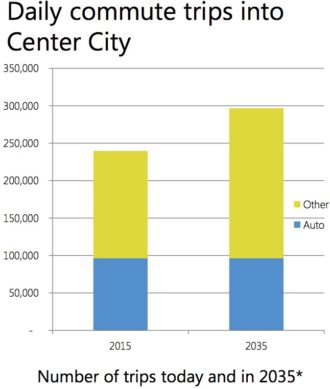
Seattle Times Editorial Board Member Brier Dudley penned his magnum opus on the rights of cars in Seattle this week, arguing that Seattle should stop building places for people to live and work until we can figure out how to get more cars into the city.
And he exhumed the “WAR ON CARS” rotting horse carcass so he could kick it a few more times, just to illustrate his point. No, I’m not joking. Here’s his opening:
Seattle can no longer deny it’s engaged in a war on cars.
— Advertisement —
Mayor Ed Murray’s new growth plan is a shock-and-awe campaign targeting anyone who dares to drive in, through or around Seattle.
Shock-and-awe! Donald Rumsfeld has been hired to bomb Seattle’s parking garages into submission. Well, Brier, you’ve got my attention. What is this menacing military strategy Seattle has against the car?
But the most radical change is Murray’s plan to stop using congestion as the criteria for whether streets are performing.
…. uh, seriously? That’s it? You’re mad the city is changing the metric they use to measure roadway level of service so that it counts people and goods instead of only counting cars? Zzzzzzzzzzz…
Come on, man! I thought you had something better than that.
Over the next 20 years, Seattle will aggressively convert street right of way to non-vehicular use, discourage creation of parking capacity as the city grows, and minimize parking at public parks, limiting their accessibility. It may also toll streets to pay for such improvements.
In what universe is 20 years an “aggressive” time frame? That’s two decades! Shit, man, you’ll be lucky if you can still afford a gallon of gas in 2036. Hell, we might be SCUBA diving in Alki storefronts by then.
Scene 1. A Seattle coffee shop in 2036. An aging white man talks to his hologram friend, who has chosen the 3D avatar of Thomas Jefferson.
AWM: This city has been going downhill ever since our socialist leaders started measuring street efficiency based on moving people and goods instead of moving cars.
3DTJ: Thanks, Obama!
End scene.
Reading Brier’s column with your bare eyeballs will really make your head spin, so I suggest finding an unlocked car, putting the column on the outside of the windshield, then reading it from the driver’s seat. Ahh, now the words line up and make sense.
From Brier’s perspective, people don’t count if they aren’t in a car.
Most of all, this shift gives the finger to those who drive cars, meaning nearly all residents and businesses.
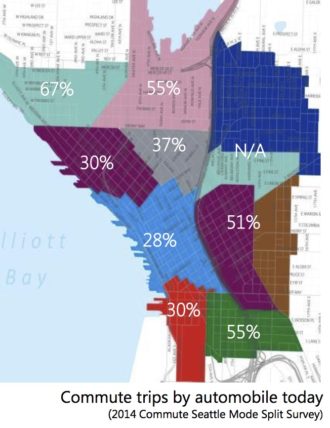 Brier, the city has moved on. The vast majority of people who work in our most congested center city area already do not drive there. In recent years, the number of Seattle residents who drive alone to work dropped below 50 percent. This is a good thing, and a trend the city needs to encourage if it wants to continue growing. Which is really all this plan is saying.
Brier, the city has moved on. The vast majority of people who work in our most congested center city area already do not drive there. In recent years, the number of Seattle residents who drive alone to work dropped below 50 percent. This is a good thing, and a trend the city needs to encourage if it wants to continue growing. Which is really all this plan is saying.
Seattle needs to think bigger. As the state hub of commerce and culture, its streets are critically important to millions of people, most of whom don’t have the option of riding a bus or a bike instead.
So because many people today “don’t have the option” to take a bus or bike, Seattle shouldn’t work to increase access to safe biking and efficient transit? Don’t you see the contradiction in this line of thinking?
Congestion also hurts Seattle’s cultural vitality. Arts organizations are losing patronage as people give up trying to drive and park in the city.
[^ citation missing]
There aren’t enough close-in residents to support all the arts, clubs and eateries. They must draw people regionally.
Again, [^ citation missing]. But worse, Brier then argues:
To ensure streets aren’t overloaded, cities must use level-of-service standards to grade performance. If streets fail, cities can limit development until improvements are made.
There (supposedly) aren’t enough people living close to businesses and arts orgs, so Seattle should stop building homes and jobs near those businesses and arts orgs? I think Brier Dudley and Brier Dudley need to sit down and hash out their differences.
Seattle’s going its own route. It says single-occupant vehicles are inefficient so reducing them improves level-of-service. That’s debatable.
Actually, it’s not debatable:
Finally, he gives up the game in the last paragraph, writing:
Worst of all, City Hall’s assuming that driving is optional — a lifestyle choice — and it can force people to change how they live.
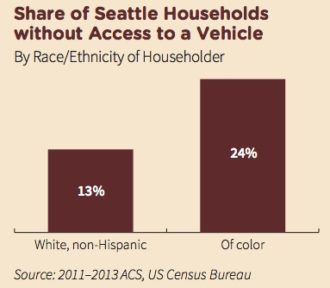
To Brier, the concept of “people” is essentially interchange with “cars.” Nevermind that there are a whole lot of people in Seattle who do not drive (including one in four non-white households), they don’t count.
And nevermind that Seattle added 15,300 new residents last year (and that the city will continue adding 40 more people every day) who arrive without an established transportation method around the area and are willing to use the easiest and most cost effective method available.
The only people who count are the people who are already here, already drive everywhere and don’t want to change or invest to help other people make different transportation choices than they make themselves.
Give it up. If there is a war on cars in Seattle, it’s a civil war. Your enemy isn’t bike lanes or bus lanes or updated level of service planning metrics. Your enemy is basic geometry. As the saying goes, “You aren’t stuck in traffic, you are traffic.”
Seattle does not have any more space for roads and parked cars, and it hasn’t for a long time. So Seattle’s job is to plan for a city that can grow in residents, jobs and culture. It’s sad that the Times Editorial Board doesn’t want to be part of the city’s future, but they’re digging their own grave right next to that dead “WAR ON CARS” horse.

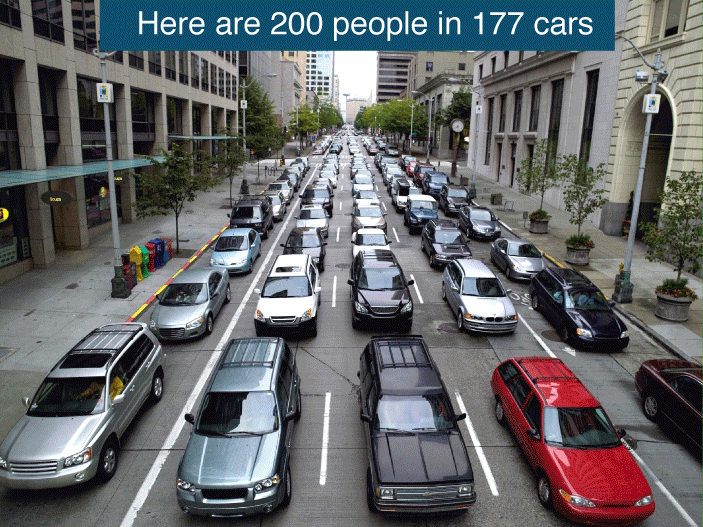



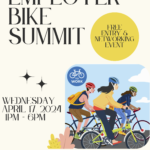





Comments
52 responses to “Times: Stop building places for people until we can fit more cars”
You forgot to remind people to not read the comments.
If you read it as an Onion-style satire piece, it makes much more sense. Oh Brier, your biting wit is unmatched!
I agree with Brier with a twist:
I think we should stop building places for people to live and work until we have safe ways for all those people to walk/bike/transit. :)
Step one is making it safe to walk/bike/transit for the existing people that live here. Adding more people before then only hurts. I don’t understand density for the sake of density. I understand density for efficiency of services, or density to prevent environmental waste, etc. But I have no desire to be more crowded for no benefit.
You might think this is a NIMBY attitude, “But all these people need to go somewhere, if not here then they will just sprawl somewhere else!”… well fine, let them. I have no desire for Seattle to be like SF/NYC/Boston.
Density is understandably not for everyone. The reality of Seattle’s geography is that it’s not really a trade-off between density and sprawl. It’s either density or paving over the Cascades. I’ll take density any day over losing the nature and mountains that surround this place. If you do not like dense cities, there is certainly no shortage of sprawling and cheaper cities to choose from in this country…
Your statement assumes growth. Growth, by definition, is not sustainable long term. This is the problem we face.
@taggart growth, while it globally can’t continue unabated, will go on locally for several more decades. The trend of urbanization alone, not counting the fairly level birthrate, rising education, and immigration levels in the united states will fuel growth for the next 20 years.
You propose San Francisco’s solution, which didn’t work out.
It’s impossible to pay for substantial improvements without economic & population growth.
bike and ped infrastructure is *cheap* compared to roads. transit is expensive, but can be cheaper than cars if done right.
but mostly I just want the new infrastructure that _is_ built to be built with bike/peds in mind as the primary goal.
we don’t have to make a faustian pact with the developers/Amazon/etc, “OK we’ll let you turn the city into yuppie glass highrises with 5x the people in exchange for lightrail, bike lanes, and crosswalks” We’re getting a pretty crappy deal…
That really isn’t true. You need some excess revenue in order to pay for improvements but you don’t need growth. Take a look at Switzerland as an example.
On the other hand, growth for some time into the future is inevitable. Whether we want it or not, it’s coming.
Recently moved from Seattle to San Francisco and they have really FUBARed it here. Seattle drivers are way nicer to bikes and the transit infrastructure here is falling apart. On the other hand density and yuppie takeover of Seattle is inevitable but we can push now for the changes we need to make it more livable despite the population boom. SF has not made a real effort but they are too far gone. Seattle still has a chance, so the “War on Cars” will be a good thing in 10 years.
That’s precisely why I haven’t moved to SF, despite having family in the Bay Area. They messed up housing, and they failed to make transit or the walk/bike environment appealing enough to warrant paying for a million dollar house.
That said, if any major US city made their downtown car-free, I would move there in a heartbeat (regardless of housing prices). I’m just waiting for it to happen. It would be nice if it was Seattle, but I’m not that picky.
It is an uphill struggle to make people realize we don’t need more roads and cars in dense cities, and that streets can be reorganized to support walking, biking, transit, skateboarding, etc and still have a vibrant and growing economy.
In fact a pleasant and safe urban environment makes people want to live and work here.
Times change and some people are dinosaurs.
THANK YOU!
That piece made me RAGE
Your piece makes me feel less RAGE!…. ok, still some rage.
Great retort! The curmudgeons on NextDoor are posting the Dudley hit-piece as if it was Moses coming down the mountain with the 10 commandments on stone tablets.
It got my hopes up that something like Buenos Aires’ pedestrian street transformation was in the works.
Obligatory “no one goes downtown, it’s too congested there”
Someone needs to put that quote on a coffee mug or tee-shirt.
Here you go:
http://imgur.com/a/J9JUC
I wish people would actually try to argue rationally. You like your car, you want to drive, fine, maybe come up with some arguments about not being cold and wet or having to carry heavy things or something, but don’t turn a blind eye to the obvious geometry. Cars=big, bikes/peds=small. You can fit more small things in the same space. Surprise!
The thing that gets me is Dudley’s short sited assumption that by simply optimizing what we have for cars – all lanes allowable for SOVs, best possible light timing, etc. – that some how we will be able to reduce congestion long term. No doubt it would short term.
But Dudley didn’t seem to want to talk about what happens if you optimize for cars and then still have congestion 10 years later.
It’s better to bite now and build the transit and multimodal facilities.
Yeah, this is truly the most maddening thing about these sorts of columns. Don’t like bikes and buses and walking? Fine. But provide an alternative plan. There are 50,000 people moving to the Puget Sound area every year. That’s like adding an entire city of Sammamish. What do you think traffic is going to be like in 2025 under the status quo you’re trying to preserve?
Eagerly awaiting the follow-up column on how we should spend $1 billion on buying up ROW and demolishing buildings and sidewalks in order to widen Denny Way to 10 lanes.
Yeah exactly, destroy all those big expensive buildings housing lots of people and high paying jobs, wipe them all off the tax roles for new and wider free government roads exclusively for cars… because cars are good for the economy, right?
It’s funny/sad that when I talk with people who argue, “we need moar room for cars! a13ASG!#%!&” they fall into a couple of interesting categories.
1. They moved here in the 1970-2000 period and bought a house/condo and grew accustomed to a pleasant life, driving to work downtown, driving out to ballard to a friends, then back home to queen anne. This life, with the painfully slow transit and traffic, has become impractical for them. They are justifiably upset, but seem to reject truly useful transit and local street improvements. They are in denial.
2. A group of people who work in the city but were priced out of the city since they moved here. Most of these people grew up in some form in the metro area and never considered living in Seattle because there were no affordable 3 bedroom homes/condos/apts for their family. They usually make 60-200k/yr before tax. They are precisely the people who would benefit from more dense development and easy transit. But they seem both of those as an assault on the little niche they have carved out driving from Kent/Lynnwood/Federal Way.
Actually a lot of folks are looking farther South. Tacoma still has affordable housing for those in that income bracket. And with the express bus, Sounder Train, it’s quite do-able.
Perfect. Thanks Tom!
I was thinking along Hutch’s line. The way to make room for more cars is demolish buildings! Buildings are what truly constrict streets. Start with taking down all the Amazon and Gates buildings in SLU. That will fix the problem with too many new people moving here, too.
The incredible part is that they see nothing hypocritical about doing continued investigative journalism about the local impacts of ocean acidification, while railing against the changes that would actually make Seattle a more sustainable city and reduce our carbon output.
I guess they actually want more acidification so they can sell more papers?
They are taking the Wall-Street journal approach. The reality of the word we live in supports almost all of the liberal/democrats positions so to provide balance they load up their editorial and opinion sections with extremely conservative view points that are completely disconnected with reality. This helps support the angry white man viewpoints so they keep renewing their subscriptions.
I think the disconnect in the Seattle Times is part of a larger disconnect. I hear people talk about how global warming is such a problem. Then as a solution, they’ll say to use reusable bags. As if disposable bags is a major contribution to global warming. Maybe it’s what’s in the bag. But it’s hard to admit that actually making non-negligable steps is difficult.
I think I’m guilty of this same disconnect. To give one example out of many, I still use the dryer at my house. My reasons for not hang drying are about as good as my reasons for not flossing. I’m either doing important things or doing fun things, and some things simply don’t seem to happen. So there I go using a significant amount of electricity and natural gas to do something that I could just get for free outside.
Even when it comes to transportation, though I bike in town, I’ll entirely fly if it’s convenient, despite flying being a huge source of Carbon.
It is simple really. Once population density reaches a certain point, cars don’t work anymore because there is not enough space for everyone to use a personal vehicle to get from point A to point B. You can not build enough highways or parking lots. Seattle is at the clumsy transition from a town to a big time real city. Real cities have transit options other than personal vehicles BY NECESSITY. I hate that people see this as a war on cars. It is just that cars don’t work in a dense metro area. If you can’t deal with that, it is time to move to the suburbs. Maybe Brier or whatever the hell his name is needs to move to Bellevue? Oh wait, the traffic is a nightmare there, too. They sure do love their cars though. Maybe Federal Way or Fife would be better.
They claim to represent the free market and what’s best for the economy while having a blind devotion to the automobile. Yet their solution is literally to use the power of the government to freeze economic growth because it is no longer compatible with their world built around easy motoring. Traffic and Parking!!! Then we must forbid density! No more growth! No more companies bring jobs to town!
It is only transit, walking and bicycles, all spatially efficient modes, that can continue allowing our economy to prosper and grow, there is still plenty of room for people and jobs under this model. We have reached the carrying capacity for the automobile model.
I can’t get too jacked up over the Dudley editorial. The Seattle Times is rapidly becoming irrelevant. This editorial is just pandering to what is left of their readership – who are also becoming irrelevant. I’ve had similar arguments with Seattle motorheads for decades. Changing minds is just really hard. As much as I’d like to rant and rave along with you (and believe me, I have), it doesn’t have the desired effect. People just further entrench themselves behind the wheel, while raving right back at you.
It sounds like he is from Southern California or something. A few forces could help get more people on foot and on bikes out. Maybe gas at 10$ a gallon. A tax (250? 500?) a year to park or drive in the city.
The more cars we get rid of the more livable the city. Those that love their cars should go somewhere that has congestion and infrastructure to support this outdated mass transit.
I find it amazing that the newspaper prints such an opinion.
The Seattle Times sells itself to neo-liberal/conservative baby-boomers. I’m not sure their reader’s opinions are much different than this.
We’ve done the optimize for single occupancy vehicle thing for about 100 years or so. It’s been tried and proven a bad idea for cities to keep adding more road and parking capacity. So unless we’re talking self-driving cars or some other revolutionary development, let’s stop this madness.
[…] Seattle Times Goes On Screed Against Imagined “War On Cars” (Seattle Bike Blog) […]
Dudley should start a movement and give his house to the City for free to be turned into a wider street or parking lot/garage. Put his money where his mouth is, because I don’t know how else we can fit more cars.
;-D Yep!
Seattle Times either doesnt get it on the need of lightrail or they are just trolling for clicks, anyone should know the need of better transportation and its something we should have gotten in the 1970s……If we dont do light rail now then our children will have to pay an even bigger price like we are now since our generations past didnt care enough for it
Excellent post.
The thing that drives me crazy is that it’s the people that actually need to drive that would benefit the most if others had options. And here’s the thing – we all fall into both camps.
Most people need to drive at some point. Maybe it’s just on Tuesdays because of tight scheduling or for a few months while recovering from an injury or even for a couple of years while they have three kids to shuttle to after-school activities. Some people always need to drive – delivery drivers, contractors, the disabled.
These people would stand to benefit the most if more able-bodied folks with flexibility had more options to get around. If everyone took an alternative mode of transportation even one day a week well, that would be a 20% reduction in traffic.
Yep, that’s the argument I give to people who say “but I need to drive”.
“If everyone took an alternative mode of transportation even one day a week well, that would be a 20% reduction in traffic.”
Um, no. Why do bicycle advocates bring up induced demand when talking about road widening or highway projects but argue that congestion will disappear if more people ride bikes or take transit? We can’t have it both ways.
Vehicles are like a gas: they fill up the space you give them. Economically vibrant cities will always have congestion.
You are correct that it is not that simple; I actually started to type a parenthetical to that effect but had to run. Induced demand would definitely result in far less than a 1 to 1 benefit for defectors but induced demand applies whether we invest in more auto infrastructure or more transit. SOVs don’t scale with density so our dollars are better spent on alternatives. My comment was directed at the article’s War on Cars narrative that every dollar not spent on more highway pavement is a part of some sinister plot. (Not to mention that limiting development only incentives more driving through lengthy commutes.)
When the power went out downtown today we closed down the office. My coworkers sat in traffic while my ride home was a few minutes longer at best. Congestion is one thing but conditions constantly bordering on gridlock turn any minor disruption into a serious problem. I am very fortunate to have the ability to commute by bike, I feel bad for people stuck in traffic. My coworkers don’t drive to work because they are stupid or evil. It’s the least-worst option. I think they should have more options.
A perspective on cars and space: I’m a child of Los Angeles who has spent most of his adult life in the Northwest. I’m 61 years old. My sister is 8 years my senior. She learned to drive the same year that the #10 aka Santa Monica Freeway opened up. I was a back seat passenger during a few of her driving lessons with our dad. Other than father/daughter stuff and driving instruction, what I remember of their conversations were things like this:
“Nobody’s on this road; that’s why I’m teaching you to drive here,” “Why’d they build this, nobody will ever use it,” “What a waste of money,” “Yeah, what a waste.” Flash forward a few decades to my sister’s employment as a limo driver. She, like many other Angelenos, never got on that freeway which connects LA International Airport with downtown, without water, a snack, and a book for the time she spent in absolutely motionless traffic. A city can NOT build enough roads for demand unless the city is demonstrably losing population; no junkie ever cleans up if they have bigger veins implanted in their arms. The Times editorial writer has his head jammed up his tush.
right on !
The issue is the inference that design for cars supports everyone’s preference but that design for “alternatives” is social engineering.
We moved here 6 years ago. She’s from Brasil, myself from the NJ/ NYC metro area. She’s never driven, we’re in midlife. I have always had a car…and since we’ve been together ( for 22 years ) I’ve been ” Driving Miss Daisy “. I thought it proper, gentlemanly. She’s always said, ” baby you don’t need to drive to such and such you can walk or ride your bike or use the bus ! Back on the east coast years ago NJ Transit had a plan for a MidTown Direct train, a full sized commuter from rural north jersey to Midtown Manhattan. Huge push back for years by car drivers who’d ben getting habitually, daily jammed up in horrendous traffic on the bridges and in tunnels going to and from NYC. Then finally the Midtown Direct got on line. In 2 weeks the ridership overwhelmed the system, NJT was totally caught off guard, even their predictions didn’t match the reality, everyone it seemed, the WallStreeters to Pennsylvanian’s going to shows in NYC clambered for the train rides! Ive traveled to the Netherlands a number of times, yes I know it;s flat and a collection of smaller countries. The dutch have trams and trains, the huge concrete car parks near each major train station I thought I was seeing ? Are in fact Bicycle Parking for Thousands of Bicycles !!!! And now their beginning to build illuminated bike paths. Back in the New Jersey recently we saw what happen to our old Mid Town Direct Train, its now double decker cars just like in Holland ! Packed !!!! Wake up Seattle you’re way behind…wayyyyyy behind…and your little skirmish over your cars is showing you’re sweet ignorant innocence. Seattle Transits recent statement of shaving off 2 to 5 years for increased local rail is also Way to Slow ! What have I done with my car ? Donated it !!! How do I get around ? Walk, Ride transit and or Bicycle. Hows my life changed ? Way way Better. Seattle is a lovely little city and we can keep her lovely despite her increasing density. The best way to help that happen is Change Your Attitude. Take a moment, seriously and review your actual use of a car…I think many folks will find they can reduce or even get rid of the thing and let me tell you getting Rid of the Thing means your entire life becomes much less worrisome, costly ( huge savings ) and Quieter so that oh lordy you’ll end up actually ” smelling the flowers that are so prolific here in the Emerald City whilst you go about your necessities in life. I mean that’s just the tip of the benefits. Quality of Living. It’s Real.
[…] Seattle’s supposed “war on cars,” thought-leaders and experts like Mike McGinn, Seattle Bike Blog, Publicola, and our own Scott Bonjukian excoriated the […]
what is the percentage of telecommuting employees in seattle?
If we just paved Lake Washington, it would be so much easier to get around.
Hmmm, Lake Washington could become a great parking lot!
[…] of people and goods around Seattle, and the Ed Board is delusional at best to say so (I dusted and found Brier Dudley’s fingerprints all over this one). American cities (including Seattle) have tried to follow the Ed Board’s […]